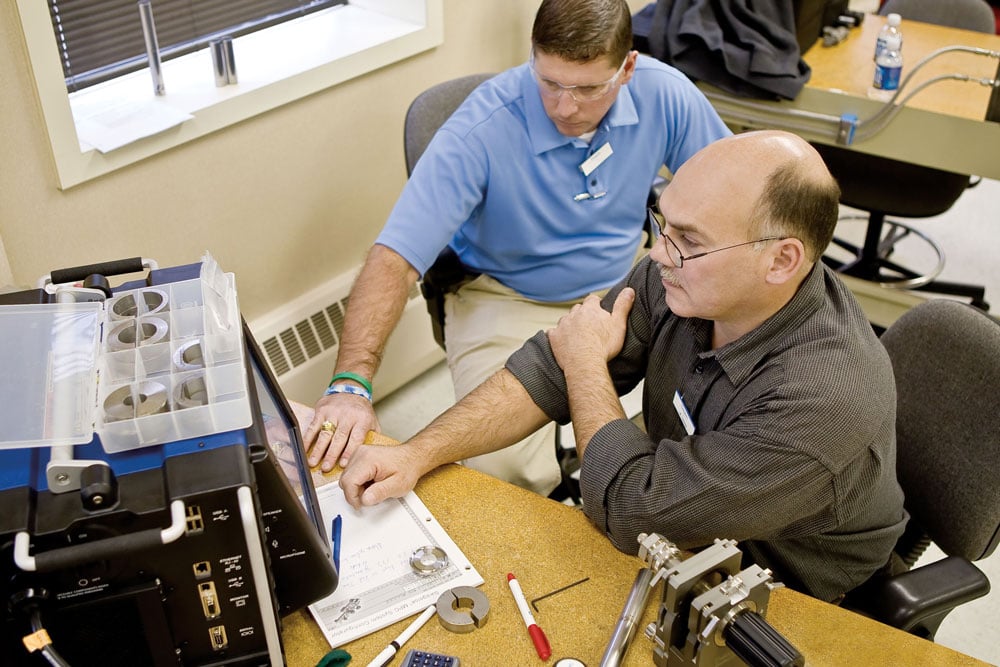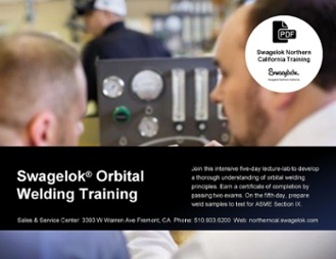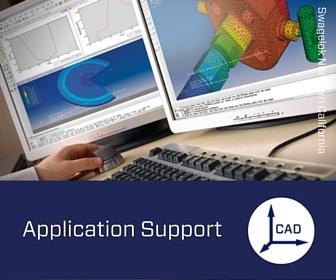Share this
Six Things To Look For In An Orbital Welding Training Course
by Jeff Hopkins on 8/9/17 8:45 AM
Poor welds are costly, so choose a course that gets the important details right
Look no further, join us for the Swagelok Orbital Welding Training course August 21-25, 2017. Get the Swagelok Orbital Welding Training brochure and then register for the course.
What to look for
There's no question that automatic orbital welding creates better, more consistent welds than doing the job manually. But that's only if someone is properly trained on the equipment. Someone still has to set the controls properly, prepare the tube ends, control the purge and shielding gasses, and set all the components in place. There's a strong case to be made that using an orbital welder requires more training than doing everything by hand. That means it's important to pick the right training program.
Here are a few things to look for.
Flexible hours
As a rule of thumb, the more training the better. Even so, make sure you get the amount of training that matches your need, whether it's an introduction to the basics or a multiple-day course that gets deep into the details.
Certified instructors
Look for courses where all program instructors are either Certified Weld Inspectors, Certified Weld Educators, or both. Also ask about how many years of experience they have in orbital welding instruction.
Process details
Orbital welding, also called gas tungsten arc welding, or GTAW, has several major components that affect the weld: arc current level, arc gap, travel speed, shielding gas, and the shape of the tungsten electrode tip. A student should go home with a thorough understanding of each element. The best training programs cover power supplies in depth, as an accurate weld depends on a steady output current, regardless of the load conditions.
Also make sure the class gives enough attention to shielding gases and the importance of purging. Shielding gases protect the electrode and the molten weld metal from atmospheric contamination. The most common shielding gasses are helium and argon in a mixture. Training should get into the preferred ratio of the gasses, and how a change in the mixture affects the weld.
Only through quality training taught by certified instructors can operators of orbital welding equipment gain the complex skills needed to meet the strict acceptance criteria in today’s welding environment.
Materials matter
Good orbital welding training addresses the main material families: carbon and alloy steels, nickel alloys, refractory metals (molybdenum, tantalum, etc.), reactive metals (titanium, zirconium, etc.), and stainless steels. After completing the class, the student should be able to inspect incoming materials and material certifications, and know how to assess the documentation.
Hands-on experience
Instructions may look straightforward and clean in print, but what happens when you actually try to put them into practice? That should happen in the class, with the instructor nearby to rely on. The real world rarely presents perfect welding situations, so it's important to try out newly learned skills under the watchful eye of an expert.
Take-aways
There's a lot to learn about orbital welding. People shouldn't be expected to carry it all in their heads, especially if they've just learned it. The course should send trainees home with written materials to reinforce what was taught in the classroom.
Author and trainer
This article is a summary of the white paper, WHAT TO LOOK FOR IN ORBITAL WELDING TRAINING PROGRAMS written by Ernest Benway, senior training specialist for orbital welding for Swagelok Company. He will be the lead trainer at the Swagelok Orbital Welding Training Course, August 21-25, 2017 at Swagelok Northern California's Fremont training center.
Additional Resources
Get in Touch
In a hurry or have a question? Please click here to get in touch - we respond fast! Or call 510-933-6200.
Share this
- Archive (465)
- Assembly Services (207)
- About (100)
- Seal Support Systems (96)
- Best Practices (88)
- Training Services (74)
- Fittings (51)
- Semiconductor Applications (49)
- Hoses and Flexible Tubing (47)
- Regulators (44)
- Tubing (42)
- Grab Sampling Systems (32)
- Sampling Systems (32)
- Gas Systems (30)
- Services (30)
- Downloads (29)
- Valves (24)
- Application Support (18)
- Orbital Welding (17)
- Case Studies (13)
- Steam Systems (13)
- Frequently Asked Questions (12)
- Tools (12)
- Measurement Devices (7)
- Subsystems (6)
- Thermal Management (6)
- September 2023 (1)
- August 2023 (2)
- June 2023 (1)
- March 2023 (3)
- February 2023 (3)
- January 2023 (4)
- December 2022 (4)
- November 2022 (4)
- October 2022 (4)
- September 2022 (1)
- August 2022 (3)
- July 2022 (2)
- June 2022 (4)
- May 2022 (1)
- April 2022 (2)
- March 2022 (1)
- February 2022 (2)
- January 2022 (3)
- December 2021 (1)
- November 2021 (6)
- October 2021 (6)
- September 2021 (8)
- August 2021 (4)
- July 2021 (3)
- June 2021 (6)
- May 2021 (6)
- April 2021 (7)
- March 2021 (5)
- February 2021 (4)
- January 2021 (6)
- December 2020 (5)
- November 2020 (6)
- October 2020 (6)
- September 2020 (8)
- August 2020 (7)
- July 2020 (8)
- June 2020 (8)
- May 2020 (6)
- April 2020 (9)
- March 2020 (7)
- February 2020 (10)
- January 2020 (21)
- December 2019 (23)
- November 2019 (21)
- October 2019 (22)
- September 2019 (21)
- August 2019 (22)
- July 2019 (23)
- June 2019 (20)
- May 2019 (23)
- April 2019 (22)
- March 2019 (21)
- February 2019 (20)
- January 2019 (21)
- December 2018 (14)
- November 2018 (19)
- October 2018 (23)
- September 2018 (17)
- August 2018 (29)
- July 2018 (11)
- June 2018 (6)
- May 2018 (5)
- April 2018 (4)
- March 2018 (5)
- February 2018 (3)
- January 2018 (3)
- December 2017 (2)
- November 2017 (4)
- October 2017 (3)
- September 2017 (2)
- August 2017 (6)
- July 2017 (4)
- June 2017 (4)
- May 2017 (4)
- April 2017 (3)
- March 2017 (4)
- February 2017 (3)
- January 2017 (3)
- December 2016 (3)
- November 2016 (3)
- October 2016 (3)
- September 2016 (5)
- August 2016 (5)
- July 2016 (4)
- June 2016 (5)
- May 2016 (3)
- April 2016 (4)
- March 2016 (5)
- February 2016 (11)
- January 2016 (1)
- December 2015 (3)
- November 2015 (4)
- October 2015 (3)
- September 2015 (4)
- August 2015 (4)
- July 2015 (8)
- June 2015 (5)
- May 2015 (3)
- April 2015 (4)
- March 2015 (4)
- February 2015 (3)
- January 2015 (4)
- December 2014 (2)
- November 2014 (3)
- October 2014 (4)
- September 2014 (4)
- August 2014 (4)
- July 2014 (5)
- June 2014 (4)
- May 2014 (4)
- April 2014 (5)
- March 2014 (4)
- February 2014 (3)
- January 2014 (4)
- December 2013 (5)
- November 2013 (3)
- October 2013 (4)
- September 2013 (3)
- August 2013 (5)
- July 2013 (5)
- June 2013 (5)
- May 2013 (3)
- April 2013 (6)
- March 2013 (4)
- February 2013 (4)
- January 2013 (8)
- December 2012 (4)
- November 2012 (6)
- October 2012 (6)
- September 2012 (4)
- August 2012 (4)
- July 2012 (4)
- June 2012 (4)

.webp?width=210&height=70&name=StickyLogo%20(5).webp)


